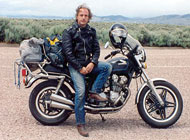Motorcycling Thoughts From Spain
We got home a few days ago from three weeks in Spain and of course I paid a lot of attention to the motorcycling scene over there and have some thoughts to pass along.
The first thing that struck me was how, unlike Paris or Rome, Madrid was actually not engulfed in small motorcycles and scooters. Yes, there were far more of them than you’ll see in any U.S. city, but not as many as in those other capitals. I think part of that may be that in Madrid–and in all of the Spanish cities we visited–the streets are generally wider, making things less congested and therefore the benefit of two-wheeling it is lessened. Just my speculation.
I was also interested to see that the Spanish seem to do a lot less lane-splitting. That seemed to be due to there not being enough room to get through up the middle when traffic stopped at red lights. Instead, the riders would filter to the front as much as they could by riding in the gutter–or even up on the sidewalk–or riding down the center stripe or even over into the oncoming lane. Then, as everywhere, when the light changed they would blast ahead.
Small bikes and scooters, and even a surprising number of larger bikes, were very common throughout the older, medieval areas of the cities where the streets are extremely narrow. We had rain off and on and I had to wonder how their tires gripped on the cobblestones and marble that were so common. I have a pair of Rockport shoes I took along and they slipped like crazy on wet marble, so much so that I quit wearing them if it was wet out or rain threatened. Presumably the tires had better grip.
I noticed how many of the scooter riders cruise along with one foot down. It makes sense. In the stop and go of working your way through dense city traffic you would forever be lifting your feet and putting them back down again. Many just don’t bother.
The city with the most bikes and scooters turned out to be Barcelona, the last stop on our trip. At last I was seeing the hordes of bikes I had expected to see in Madrid. Mostly scooters. Here it was amazing how sometimes almost entire blocks were given over to motorcycle/scooter parking only, and every slot was in use. Rather than stop in traffic and roll backward into a parking slot, the common approach was to pull up on the sidewalk and drive straight into the slot off the curb. Barcelona also has a large number of broad streets so actual lane-splitting, coming up the middle between lanes of cars, was much more common.
It was particularly interesting on Sunday, April 24, when we were driving from Sevilla to Arcos de la Frontera and the roads were full of motorcycles. Motorcycles by the hundreds, if not thousands. What, does every Spaniard go riding in the country on the weekend? I couldn’t believe how many bikes there were.
Well, we figured it out. We got to Arcos and were having beers and tapas in the bar at our hotel and they had the TV on. They were reporting on the Spanish Gran Prix, which had been held that day in nearby Jerez de la Frontera. All those bikes we saw were people riding home after the race. Valentino Rossi won, by the way, so he’s apparently not totally washed up yet, though he’s no longer the top dog he once was.
Most of the Spanish countryside we saw was not very interesting, and didn’t look like particularly compelling riding country. The one place that was not true was in the de la Frontera area. This area of what they call the Spanish white hill towns is, as the name suggests, a very hilly area. Narrow, twisty roads going up high with fabulous views. It’s probably like that up north in the Pyrenees, too, so if you ever go to Spain to ride just head straight for the good parts.
Biker Quote for Today
Difficult roads often lead to beautiful destinations.

